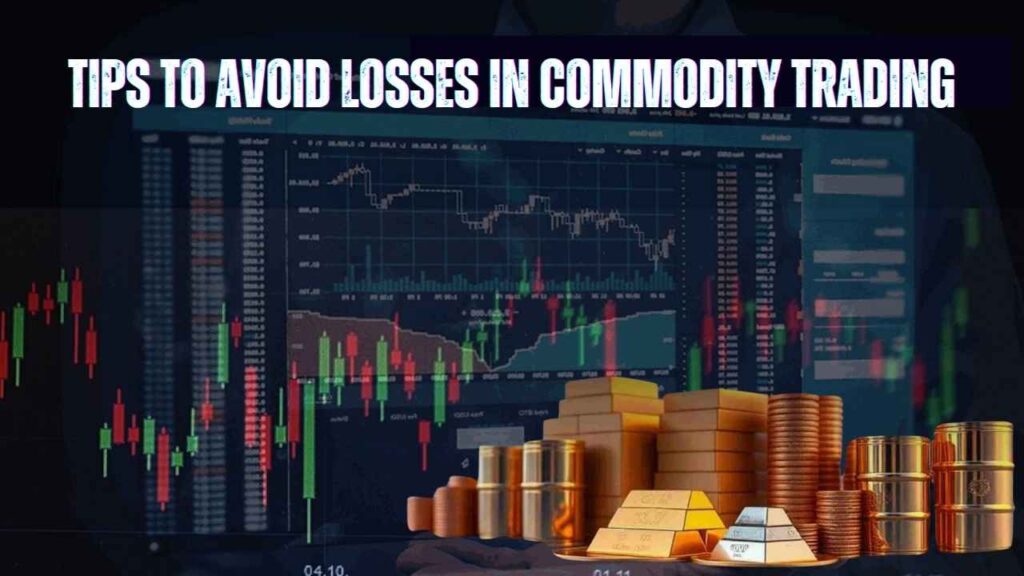Commodity markets are renowned for their volatile and sometimes uncertain price action. Geopolitical events, supply-demand mismatches, weather, and currency fluctuations can lead to sudden price movements. Although these fluctuations provide opportunities, they can also result in heavy losses if not handled effectively. This blog post presents crucial tips to prevent losses in commodity trading. Our mission is to provide new and seasoned traders with the strategies necessary to trade these volatile markets confidently.

1. Develop a Robust Trading Plan
A well-defined trading plan is your blueprint for success. It should include:
- Investment Goals: Clearly outline your short-term and long-term goals.
- Risk Tolerance: Understand how much risk you are willing to take with each trade.
- Entry and Exit Points: Define specific criteria for entering and exiting trades to avoid emotional decisions.
- Position Sizing: Determine the appropriate size for each trade relative to your total capital to prevent overexposure.
- Contingency Plans: Prepare strategies for unexpected market conditions.
A detailed trading plan helps maintain discipline and prevents impulsive decisions that can lead to unnecessary losses.
2. Use Stop-Loss Orders Strategically
Stop-loss orders are essential tools for limiting losses:
- Automatic Sell Trigger: Set stop-loss levels for each trade to automatically sell if the price reaches a predetermined level.
- Risk Control: This ensures that if the market moves against you, losses are contained and do not erode your overall capital.
- Regular Adjustments: Update your stop-loss orders as the market moves in your favor to lock in profits and reduce risk further.
Using stop-loss orders consistently is one of the best ways to protect your capital from large adverse price movements.
3. Diversify Your Trading Portfolio
Diversification is key to reducing risk:
- Spread Investments: Rather than putting all your capital into one commodity, diversify across multiple commodity types such as metals, energy, agricultural products, and soft commodities.
- Reduce Concentration Risk: Diversification helps mitigate the impact of a downturn in a specific commodity by balancing it with others that may perform better under different conditions.
A diversified portfolio helps you weather market volatility and smooths out potential losses from any single trade.
4. Stay Informed on Market Trends and News
Being well-informed is crucial for successful commodity trading:
- Economic Indicators: Keep an eye on global economic trends, inflation rates, and monetary policies that influence commodity prices.
- Industry News: Follow industry news, geopolitical developments, and weather reports that can impact supply and demand.
- Analyst Insights: Utilize research reports and expert analyses to gain insights into market trends and potential price movements.
An informed trader is better equipped to anticipate risks and adjust strategies proactively.
5. Manage Leverage Carefully
Leverage can boost your profits but also amplify your losses:
- Understand Leverage: Be aware of how much leverage you are using in your trades. High leverage can lead to significant losses if the market moves against you.
- Use Moderately: Avoid over-leveraging your positions and maintain a conservative approach, especially in volatile markets.
- Set Leverage Limits: Establish clear guidelines for maximum leverage usage to ensure your trades remain within your risk tolerance.
Managing leverage prudently is vital to maintaining a balanced risk-return profile in commodity trading.
6. Monitor Your Positions Regularly
Keeping track of your trades is essential:
- Daily Review: Monitor your positions on a daily basis to ensure they align with your trading plan.
- Adjust as Needed: Be ready to adjust your positions based on changing market conditions, such as tightening stop-loss orders or reducing exposure if volatility increases.
- Use Technology: Leverage trading platforms and analytical tools to stay updated on market trends and performance metrics.
Regular monitoring helps you catch potential losses early and take corrective actions promptly.
7. Continuously Educate Yourself
The commodity market is constantly evolving, and continuous learning is crucial:
- Attend Seminars/Webinars: Participate in industry seminars and webinars to stay updated on market strategies and risk management techniques.
- Read Market Reports: Regularly read financial news, market analyses, and research reports.
- Practice with Demo Accounts: If you’re new to commodity trading, consider using demo accounts to practice strategies without risking real money.
Ongoing education helps you refine your strategies and adapt to changing market dynamics, ultimately contributing to better risk management.
Final Thought
Though commodity trading is full of tantalizing opportunities to make money, the risks that come with it need to be handled with a disciplined and knowledgeable mindset. Having a solid trading plan, applying stop-loss orders, diversification of your portfolio, staying aware, controlling leverage, and being constantly educated, you can ride out volatility while minimizing the possibility of major losses. Commodity trading is not about avoiding risk but about wisely managing it so that you benefit from growth over the long haul.
Frequently Asked Questions (FAQ)
Q1. What is commodity trading?
A: Commodity trading is the purchase and sale of raw materials such as metals, energy commodities, and agricultural products on specific exchanges. It is guided by supply and demand, geopolitical crises, and economic trends.
Q2. How can stop-loss orders help limit losses?
A: Stop-loss orders trigger a trade automatically when the price hits a set level, hence capping losses if the market goes against you.
Q3. Why is diversification important in commodity trading?
A: Diversification diversifies risk over various commodities and minimizes the effect of a major loss in any given market or asset class.
Q4. What role does leverage play in commodity trading?
A: Leverage enables traders to have control over larger positions than the initial capital otherwise would, but it also raises the risk of potential losses. Handling leverage with care is the essence of risk management.
Q5. How can I stay updated on commodity trading trends?
A: Keep abreast of market news, economic announcements, and expert analysis. Use trading platforms with live feeds and attend industry events to be informed.











Saiyaara movie